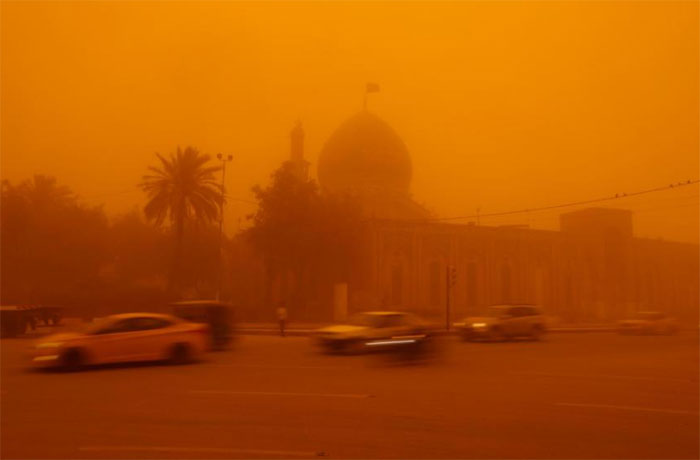At least 2,000 people hospitalized because of sandstorms in Iraq
On May 16, Iraq continued to experience a sandstorm, causing at least 2,000 people to be hospitalized due to respiratory problems. Airports, schools and government offices across the country were closed.
According to AFP news agency, this is the eighth sandstorm in the past month in Iraq, the country is suffering from severe drought and low rainfall due to the impact of climate change.
On May 16, a thick cloud of orange sand covered the capital Baghdad and many other cities, including the city of Najaf in the south and Sulaimaniyah in the autonomous Kurdish region to the north.

Sandstorm shuts airports, schools and government offices across Iraq
Yellow and orange sand covered the roofs of buildings, cars and crept into houses. Iraqi authorities say seven of Iraq's 18 provinces, including Baghdad, have ordered the closure of government agencies.
Meanwhile, medical facilities remain open to support those most at risk, including the elderly and those with chronic respiratory and cardiovascular diseases.
As of mid-May 16, at least 2,000 people had been hospitalized across Iraq due to the need for oxygen, said Iraqi Health Ministry spokesman Seif al-Badr.
Among them was Hadi Saada, 70, who was hospitalized in the intensive care unit of Sheikh Zayed Hospital in Baghdad. According to AFP, this is the third time Mr. Saada has been hospitalized due to difficulty breathing due to a sandstorm since April.
In addition, a sandstorm on May 16 also reduced visibility to 300 meters at Baghdad airport, forcing authorities to close the airspace and suspend flights, according to Iraq's state news agency INA.
Airports at Najaf and Sulaimaniyah were closed on May 16.
Schools across Iraq were also closed and year-end exams were moved to May 17. Universities are also postponing exams.
The Iraqi weather agency predicts that the sandstorm will gradually subside on the evening of May 16.
Previously, a sandstorm on May 5 left one person dead and 5,000 people hospitalized.
The Middle Eastern country has always had sand and dust storms, but these storms have become more frequent and intense in recent years. This trend is related to too many dams, deforestation.
In April, an Iraqi environment ministry official warned Iraq could face "272 dusty days" a year over the next two decades. According to the Environment Department, this weather phenomenon could be tackled by "increasing vegetation cover and creating forests that act as windbreaks".
- 9 remarkable things about Iraq
- The Syrian war caused an unusual sandstorm in the Middle East
- The cause of sand storms raging throughout the Middle East
- Terrifying sandstorm
- Earthquake on Iran-Iraq border: There are nearly 7,000 people dead
- The United States gives Iraq thousands of artifacts dating back thousands of years
- China: The city is red when the terrifying sandstorm attacks
- Learn 4 Iraq's mighty empire
- Dust storms swept across Iran, more than 30 people were injured
- Mysterious battery in the ancient city of Iraq
- Iraqis paid with beer 5,000 years ago
- 15 people died, more than 8,000 people were hospitalized because of the heat in Japan
 13 causes of non-itchy rash
13 causes of non-itchy rash How the mouse with human ears changed the world?
How the mouse with human ears changed the world? The truth about 'fried rice syndrome!
The truth about 'fried rice syndrome! What is dental implant?
What is dental implant?